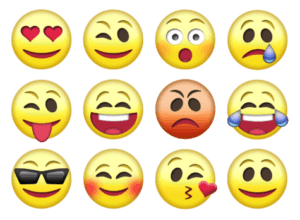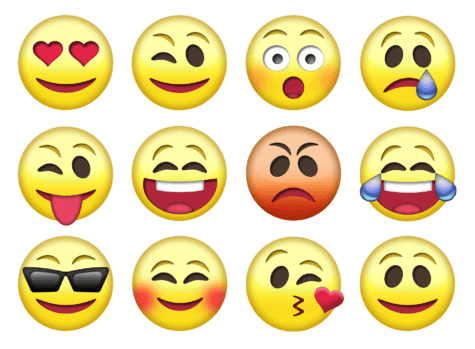BERKELEY, Calif. — Human emotions may not be as plentiful as the hundreds of emojis we use on social media, but they’re still more complex than previously believed. A new study examining the various ways that we express ourselves determined that humans display 27 distinct emotional states.
Researchers at the University of California, Berkeley recruited a diverse sample of 853 men and women to watch short five-to-ten second long video clips meant to evoke a range of reactions, hoping to measure the true spectrum of human emotions.

The study’s experimental component, which incorporated nearly 2,200 silent clips, split participants into one of three groups.
One group disclosed their unfiltered emotional reactions to 30 clips they viewed to the researchers, allowing for raw documentation.
“Their responses reflected a rich and nuanced array of emotional states, ranging from nostalgia to feeling ‘grossed out,’” says lead author Alan Cowen, a doctoral student in neuroscience, in a university news release.
A second group ranked each video in terms of the various emotional reactions it lent, ranging from anger to sexual desire. Most participants in this group gave each video similar marks when it came to the types of emotions it evoked.
A third group had participants evaluate the emotional content of a given video based on a sliding scale (e.g., how negative or positive a video was, or how exciting or boring it was).
Regardless of the group in which one was placed, nearly all participants reacted in a similar manner to any given video. Furthermore, the researchers were able to use this data to determine that humans have 27 distinct categories of emotion.
This finding is rather groundbreaking, considering how previous research had only identified six significant emotional states.
“There are smooth gradients of emotion between, say, awe and peacefulness, horror and sadness, and amusement and adoration,” notes senior author Dacher Keltner. “We found that 27 distinct dimensions, not six, were necessary to account for the way hundreds of people reliably reported feeling in response to each video.”
The research team hopes the new findings can be utilized by other scientists or doctors for further research and innovations in neuroscience.
“Our hope is that our findings will help other scientists and engineers more precisely capture the emotional states that underlie moods, brain activity and expressive signals, leading to improved psychiatric treatments, an understanding of the brain basis of emotion and technology responsive to our emotional needs,” says Cowen.
The team released an interactive map of the emotional states that each video used in the study elicited from participants that led them to their finding. Each of the 27 states corresponds to a color on the map.
The study’s findings were published this week in the journal Proceedings of the National Academy of Sciences.

Yeah, there are now 21 new states of mind. Five of them are anger, five of them are offended, and eleven of them are stupidity.
Seeing the study being done by University of California, Berkeley automatically makes me think it is not very scientific.
Berkley looks at the world upside down. Why would anyone believe one their kooky studies about emotions. They probably believe there’s 27 different genders too.
how low has the national academy of sciences fallen? and they can’t get up 🙁
Maybe we have an infinity of emotional “states”, with various feelings all having continuously variable intensities?
Like the second before my fist hits your face?
There were 6 up to Trumps election, the lib/dem/left revealed 21 more states of
emotions……..another Trump accomplishment!
That ain’t nothing compared to the “New Gender Count” being brought to us by the pervs.. Now that is a big number…
Is this what the French meant by “Viva le difference”!
These idiotic scientists have nothing better to do?
The First “Study” was completed before Opiods became popular !!!!
Did the researchers compare their results to the fraudulent Ekman “universal human emotions” revealed in the face scam?
Should be interesting.
When they have their heads stuck in their ass they feel at home, safer like they are in a country filled with only their peers.
Several studies carried out on the validity of social science research have determined that most of the published research is crap – completely useless.
https://en.wikipedia.org/wiki/Replication_crisis
https://www.insidehighered.com/views/2017/07/10/introducing-new-series-reproducibility-scientific-research-essay
Research in these fields are dominated by the need to publish a paper and the personal need to confirm a hypothesis. Since negative results are not worthy of publication, researchers are driven to discover something which shows a trend.
Here we have a study of variations in human behavior. The study carried out here typifies the outcome of a statistical analysis of a large, noisy data set. The analysis WILL inevitably reveal a finite number of fitting parameters that will adequately (by some statistical criterion) describe the data set.
But will another study on another, perhaps larger, group of people reveal the same data-fitting parameters? Perhaps, but I doubt it.
This is not science. It is an exercise in empirical data analysis.
Bingo. You are right, it is not science. It’s a similar fallacy to the way that a lot of people’s jobs evaluate their performance. They are sincerely expected to do better all the time, or to go somewhere else. Just as in the private sector, unrealistic metrics and expectations drive employees to lie and even commit fraud, in academics such unrealistic expectations drive a lot of dubious and even fraudulent research.
“This finding is rather groundbreaking, considering how previous research had only identified six significant emotional states.”
But then again, there used to be only 2 sexes.
Still are. Notice how the flakes will do anything to avoid “sex.” It’s all about some new made up feely version of “gender,” which used to be 3, and strictly a grammatical concern (mostly ignored in English, but key to the Romance Languages, as well as Slavic ones and others, I’m sure).
“…Berkeley recruited a diverse sample of 853 men and women…”
And confusion was the first emotion they encountered when participants were asked their gender.
This is not directed at you, but the quote spawned my question/comment: If they actually “recruited” a sample (people to participate) instead of a randomly selected sample, and also valued “diversity” over true population representation, it’s skewed already, therefore also invalid. And where is the control group? How many times have the results been duplicated? Oh well, pardon me- I still associate so-called modern science with what was once known as the good ‘ole scientific method.
Here are the emotional states segregated by gender:
Male:
Happy
Sad
Angry
Content
Female (and other non-males):
Pre-hormonal
Hormonal
Post-hormonal
Upset
Unhappy
Incensed
Raging
Melancholy
Detached
Whacked-out
Weepy
Sad
Angry
Horror
Fear
Anxiety
Depressed
Bitter
Heartbroken
Mournful
Somber
Sorrowful
Bereaved
Cheerless
Dejected
Despairing
Despondent
Disconsolate
Distressed
Doleful
Down in dumps
Down in the mouth
Forlorn
Gloomy
Grief-stricken
Heartsick
Hurting
Doldrums
Low-spirited
Morbid
Woebegone
You left out : Male … HORNY.
I know somebody in this thread likely already asked this, but is this study coming from people who believe there are 58 or 64 or whatever number of genders (even the leftist social engineers — I mean systems IT people- at Facebook buy this now, as reported gleefully in an article by ABCNews) ?
I mean, like this new “real” science is simply amazing. And I guess we >have to< believe everything that comes out of U. C. Berkeley, or be labeled as "N*zis", and thus be eligible for a sucker punch, mace in the face, or a bag of urine or feces thrown upon us by righteous leftist street thugs.
It’s Berkeley.
27 Distinct Emotional States is not enough.
This is all a matter of how you look at it. This discussion is the same as arguments regarding whether or not Pluto is a planet or the number of distinct flavors.
But I don’t think the scientists would just have a group of people look at pictures of Pluto and make a statement whether they think it’s a planet or not to make the determination.